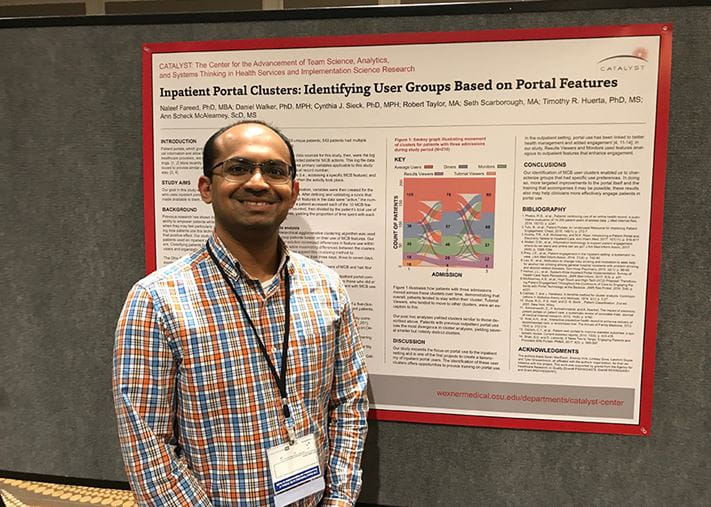
CATALYST researchers share work at scientific conference in Washington, D.C.

Naleef Fareed, PhD, MBA, was among the CATALYST researchers who attended the 11th Annual Conference on the Science of Dissemination and Implementation in Health.
By Tyler Griesenbrock
CATALYST scientific editor
Published December 12, 2018
A recent trip to Washington, D.C., gave several members of CATALYST, the Center for the Advancement of Team Science, Analytics, and Systems Thinking in Implementation Science and Health Services Research in the Ohio State College of Medicine, the chance to present their work to an audience of health care practitioners and other researchers.
Jennifer Hefner, PhD, MPH; Naleef Fareed, PhD, MBA; and Christine Swoboda, PhD, MS, made the trip to the East Coast for the 11th Annual Conference on the Science of Dissemination and Implementation in Health. The conference was co-hosted by AcademyHealth and the National Institutes of Health from December 3 through 5, 2018.
Scientific conferences offer the chance to highlight the discoveries being made at CATALYST, demonstrating what is “new and distinct” about the work being done within the center by the Ohio State researchers who call it home, Dr. Swoboda said.
“We frequently try to go to conferences to present posters or do Q&A sessions or short lectures,” she added. “We do this to present our work to other scientists so they might learn something or, conversely, if they’re really knowledgeable about the subject, they can contact us or give advice.”
Professional development is another key driver of conference attendance, Dr. Swoboda said; events such as AcademyHealth’s Science of Dissemination and Implementation Conference are important for newer researchers “to get practice presenting and disseminating their research.”
AcademyHealth, a national organization consisting of health services researchers, policymakers, and people involved in the health care field, was established in 2000 after a merger of the Alpha Center and the Association for Health Services Research. According to the organization’s website, AcademyHealth’s goals are to expand the understanding of the methods and data used in health services research, as well as boost the professional skills of researchers and increase awareness of the field.
The trio of CATALYST researchers presented four posters tied to the High Tech-High Touch project, or HT2, a project led by Principal Investigator Ann Scheck McAlearney, ScD, MS, and Executive Director of CATALYST. Along with Dr. Timothy Huerta and Dr. Cynthia J. Sieck serving as co-investigators, the research team features Dr. Susan Moffatt-Bruce, Dr. Milisa Rizer, and Dr. Jennifer Hefner. The effort is funded through a $973,109 grant from AHRQ, the Agency for Healthcare Research and Quality.
HT2 looks at how patient portals can influence the inpatient stay by conducting a mixed-methods analysis to determine how access to the technology and associated training influence patient engagement with the portal. These inpatient portals provide patients with information regarding their health care, and our team is interested in how inpatient portals affect communication between patients and their care team as well as how portal use training affects how patients use it.
“OSU is one of the first hospital systems to use the inpatient portal technology,” Dr. Swoboda said. “We’re at the forefront of this technology.”
The four posters the group presented looked at patients’ perceptions of portal use in both inpatient and outpatient settings, the role inpatient portals can play in the care of hospitalized patients, the training needs care team members have when an inpatient portal system is implemented, and how inpatient portal usage patterns can be analyzed to classify user groups.
The HT2 project is one of many research projects underway at CATALYST.
“It’s important to disseminate our experiences with implementing innovative interventions, and it’s also important to learn from other researchers’ and practitioners’ [about] how they implemented similar or different interventions,” Dr. Fareed said.
At The Ohio State University Wexner Medical Center, the inpatient portal offered to patients is Epic Systems’ MyChart Bedside, an Android tablet app. The tablets are provisioned to patients after their admission to any of the seven Ohio State Wexner Medical Center hospitals.
Events such as the Science of D&I Conference offer researchers the chance to both share findings from the research taking place at Ohio State and network with scientists from across the country and around the globe.
“During the poster presentation, many scientists studying all different topics talked to me,” Dr. Swoboda said. “A lot of them were interested in this technology for their own hospital system, or it started them on a path to find out what portal technology was in use in their hospital systems.”
Dr. Fareed said many attendees were interested in the user experience and user design aspects of technology interfaces such as MyChart Bedside.
“We had lots of questions from clinicians and researchers,” he said. “It seems like this is still new to clinicians from other health systems, so they’re trying to understand how it can be used to engage patients.”
Patient portals weren’t the only subject of discussion at the conference. Other presenters discussed topics such as opioids, maternal and child health, compliance among hospital systems, and how to improve entire health care systems.
